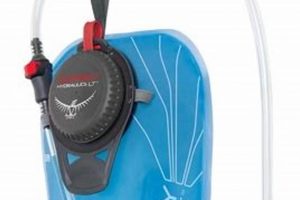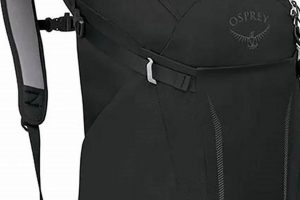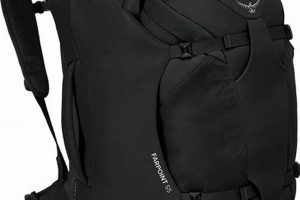This type of carrying equipment is designed to accommodate approximately 30 liters of volume. It is primarily used for day hikes, short overnight trips, and everyday carry purposes. The equipment is characterized by its capacity, construction materials, and features tailored for comfort and organization.
Such equipment offers a balance between capacity and portability, making it suitable for activities where a larger backpack would be cumbersome but a smaller bag insufficient. Its design often incorporates features such as adjustable harnesses, padded hip belts, and multiple compartments to distribute weight evenly and facilitate efficient packing. The popularity of this equipment stems from its versatility and adaptability to various needs.
The subsequent sections will delve into specific features, materials, and user considerations when selecting this kind of equipment. This includes an examination of its construction, ergonomic design, organizational features, and suitability for various activities and body types. These elements are crucial in determining the overall performance and user satisfaction with the equipment.
Selection and Utilization Guidance
This section offers practical recommendations for choosing and effectively using a pack of this volume. The following tips address essential aspects of selection, packing, and maintenance, ensuring optimal performance and longevity.
Tip 1: Evaluate Intended Use: Before purchase, clearly define the primary purpose. Day hikes necessitate a different feature set than overnight trips or daily commutes. A model designed for hiking may prioritize hydration compatibility and trekking pole attachments, while an urban model may emphasize laptop protection and streamlined aesthetics.
Tip 2: Assess Torso Length: Backpack sizing is crucial for comfort and weight distribution. Measure torso length from the iliac crest to the C7 vertebra. Consult the manufacturer’s sizing chart to determine the appropriate size. An ill-fitting pack can lead to discomfort and potential injury.
Tip 3: Consider Suspension System: The suspension system, including the harness and hip belt, is responsible for transferring weight from the shoulders to the hips. Evaluate the padding and adjustability. A well-designed suspension system enhances comfort and reduces strain during extended use.
Tip 4: Prioritize Organization: Internal and external pockets facilitate efficient organization of gear. Assess the quantity and configuration of compartments. Consider features such as dedicated laptop sleeves, water bottle pockets, and external attachment points. A well-organized pack simplifies access to essential items.
Tip 5: Distribute Weight Evenly: Proper packing is essential for optimal comfort and stability. Place heavier items close to the back and towards the center of the pack. Distribute weight evenly between both sides. Uneven weight distribution can lead to imbalance and fatigue.
Tip 6: Utilize Compression Straps: Compression straps secure the load and minimize shifting within the pack. Tighten straps to compress the contents and maintain a compact profile. Proper compression enhances stability and reduces the risk of gear displacement.
Tip 7: Inspect and Maintain Regularly: Periodically inspect the pack for signs of wear and tear. Clean the pack with mild soap and water, avoiding harsh chemicals. Repair minor damage promptly to prevent further deterioration. Regular maintenance prolongs the life of the pack.
Adherence to these guidelines will aid in selecting appropriate equipment and maximizing its usability. By carefully considering these factors, users can enhance their experience and minimize potential discomfort or inconvenience.
The subsequent section will explore specific use cases and environments where this equipment excels, further illustrating its versatility and adaptability.
1. Capacity
Capacity, in the context of this equipment, refers to the internal volume available for storing and transporting items. It is a primary factor influencing the range of activities and duration of trips for which the equipment is suitable. The stated capacity dictates the limitations and potential uses of the equipment.
- Volume Measurement
Capacity is typically measured in liters, indicating the total cubic volume of the main compartment and any additional pockets. A 30-liter capacity allows for the carriage of essential gear for day hikes, short overnight excursions, or everyday carry needs. The actual usable space may vary slightly based on the design and internal organization.
- Load Management
Capacity influences the weight and distribution of the load. A larger capacity may tempt users to carry more items, potentially exceeding comfortable or safe weight limits. Proper packing techniques and weight distribution are crucial to maintain balance and prevent strain, regardless of the equipment’s capacity.
- Activity Suitability
The 30-liter capacity renders the equipment suitable for specific activities. Day hiking requires sufficient space for water, food, extra clothing, and safety equipment. Overnight trips necessitate a balance between carrying capacity and pack weight. Everyday carry applications benefit from a compact design while accommodating essentials such as laptops, books, and personal items.
- Comparison with Alternatives
Capacity differentiates this piece of equipment from smaller and larger alternatives. Smaller backpacks, typically under 20 liters, are suitable for minimalist day trips or urban environments. Larger backpacks, exceeding 50 liters, are designed for extended backpacking trips. The 30-liter capacity provides a middle ground, balancing portability and storage space.
The interplay between capacity and other design elements, such as suspension systems and organizational features, determines the overall utility and performance of this equipment. A proper understanding of capacity and its implications is essential for selecting the appropriate equipment for specific needs and activities.
2. Durability
Durability is a critical attribute, significantly impacting the long-term performance and value of this equipment. It dictates the ability to withstand various environmental conditions and physical stresses encountered during intended use. The robustness of construction materials and design directly correlates with the lifespan and reliability of this equipment.
- Material Selection
The choice of materials plays a pivotal role in determining durability. High-denier nylon fabrics, reinforced stitching, and water-resistant coatings are common features that enhance resistance to abrasion, tearing, and moisture penetration. For example, the use of ripstop nylon minimizes the propagation of tears, extending the usability of the pack even if punctured. The specific materials selected influence the equipment’s weight, cost, and overall performance.
- Construction Techniques
Beyond material selection, construction techniques contribute significantly to durability. Reinforced stress points, such as attachment loops and zipper junctions, are crucial for preventing premature failure. Bar-tacking and double stitching are commonly employed to enhance the strength of seams and attachment points. The precision and quality of construction directly affect the equipment’s ability to withstand heavy loads and repeated use.
- Hardware Components
The quality of hardware components, including zippers, buckles, and adjustment straps, also influences overall durability. Robust zippers with durable sliders resist breakage and separation, while high-quality buckles and straps maintain secure closures under stress. Metal hardware, such as aluminum frame stays, offers greater strength and resistance to deformation compared to plastic alternatives. The reliability of these components is essential for ensuring the functionality and longevity of the pack.
- Environmental Resistance
Durability encompasses resistance to environmental factors such as UV radiation, water, and temperature extremes. UV-resistant fabrics prevent degradation and fading over time, while water-resistant coatings protect contents from moisture damage. The ability to withstand temperature fluctuations without compromising structural integrity is also important, particularly for equipment used in diverse climates. Environmental resistance directly impacts the equipment’s versatility and suitability for various outdoor activities.
The collective impact of these facets establishes the overall durability profile. Equipment constructed with high-quality materials, reinforced construction techniques, and robust hardware components exhibits greater resilience to wear, tear, and environmental stressors. The extended lifespan and reliable performance justify the investment for individuals requiring durable carrying solutions.
3. Ergonomics
Ergonomics, in relation to carrying equipment of this type, pertains to the design principles that optimize user comfort and minimize physical strain. The effective implementation of ergonomic considerations directly impacts the wearer’s experience, particularly during extended periods of use. The design aims to create a more natural and efficient interaction between the user and the equipment.
- Torso Length Adjustment
Torso length adjustment mechanisms allow the equipment to be tailored to the wearer’s specific body dimensions. An adjustable harness enables the user to position the hip belt and shoulder straps at the optimal points for weight distribution. Improper torso length adjustment can result in excessive strain on the shoulders or lower back. For instance, if the torso length is too short, the hip belt may sit too high, transferring weight to the lumbar region instead of the hips.
- Hip Belt Design and Padding
The hip belt is a crucial element in transferring the majority of the load weight to the wearer’s hips, rather than the shoulders. The design of the hip belt, including its width, shape, and padding, influences its effectiveness and comfort. A wider hip belt distributes pressure more evenly, reducing localized discomfort. Adequate padding, constructed from materials such as closed-cell foam, cushions the hips and prevents chafing. A contoured hip belt that conforms to the natural curvature of the hips further enhances comfort and stability.
- Shoulder Strap Contouring and Padding
Shoulder straps should be contoured to fit comfortably around the wearer’s shoulders and chest, avoiding pressure points or restrictions of movement. Padding within the shoulder straps cushions the shoulders and reduces friction. The shape and thickness of the padding influence its effectiveness in distributing weight and preventing discomfort. Mesh materials are often incorporated to enhance breathability and minimize perspiration buildup. S-shaped shoulder straps are a common design feature that follows the natural curvature of the upper body, enhancing comfort and stability.
- Load Lifter Straps
Load lifter straps connect the top of the shoulder straps to the equipment’s frame, pulling the load closer to the wearer’s center of gravity. Tightening these straps lifts the weight off the shoulders and improves balance. Proper adjustment of the load lifter straps ensures that the top of the pack remains close to the back, preventing it from sagging away and creating strain. The angle of the load lifter straps should be approximately 45 degrees for optimal effectiveness. These straps are essential for maintaining proper posture and reducing fatigue during extended hikes or travel.
These ergonomic considerations collectively contribute to a more comfortable and efficient carrying experience. A well-designed pack minimizes physical strain, allows for greater freedom of movement, and enhances overall user satisfaction. Attention to these details is paramount for individuals who regularly carry loads for extended periods, promoting both comfort and long-term physical well-being.
4. Organization
Efficient arrangement of contents within a 30-liter pack directly impacts accessibility, weight distribution, and overall usability. The design and implementation of organizational features determine the extent to which users can efficiently store and retrieve gear, contributing significantly to the equipment’s practicality and user satisfaction.
- Internal Compartmentalization
Internal compartments facilitate the segregation of items based on category or frequency of use. A dedicated laptop sleeve, for instance, provides protected storage for electronic devices, while mesh pockets can secure smaller items like chargers or accessories. Separating clothing from equipment within the main compartment prevents contamination and simplifies retrieval. Effective compartmentalization minimizes the need to unpack the entire contents to access specific items, enhancing operational efficiency.
- External Pocket Configuration
External pockets augment storage capacity and provide immediate access to frequently used items. Water bottle pockets, situated on the sides, allow for hydration without requiring the removal of the equipment. A top pocket can accommodate sunglasses, maps, or other small items requiring quick access. Front panel pockets are often utilized for stowing rain gear or extra layers. The strategic placement and design of external pockets enhance convenience and operational readiness.
- Attachment Points and Compression Straps
External attachment points, such as daisy chains or webbing loops, enable the carriage of oversized items that cannot be contained within the main compartment. Trekking poles, ice axes, or sleeping pads can be securely attached to the exterior, freeing up internal space. Compression straps stabilize the load and prevent shifting, maintaining a compact profile and improving balance. These features enhance versatility and adaptability to diverse carrying needs.
- Color Coding and Labeling
While not a physical feature, employing color-coded stuff sacks or labeling compartments enhances organizational efficiency. Assigning specific colors to categories of items, such as clothing, food, or electronics, simplifies identification and retrieval. Labeling compartments with descriptive tags allows for quick referencing of contents. These methods, although simple, streamline the packing and unpacking process, minimizing time spent searching for specific items.
Effective organizational strategies, whether integrated into the design or implemented by the user, maximize the functionality of this equipment. The thoughtful arrangement of contents not only simplifies access but also contributes to a more comfortable and efficient carrying experience, underscoring the importance of organization in optimizing the utility.
5. Weight
The weight of this equipment is a critical factor influencing user comfort and overall efficiency, especially during prolonged activity. The inherent design challenge involves balancing durability and organizational features with the need for a lightweight structure. An excessively heavy pack can lead to increased fatigue, reduced mobility, and a higher risk of injury. Conversely, a pack that prioritizes weight reduction at the expense of essential features or material strength may compromise functionality and longevity. For instance, a day hiker carrying water, food, and essential safety gear will experience a significant difference in exertion levels depending on whether the equipment weighs 2 pounds versus 4 pounds when empty. This difference is compounded over the duration of a multi-hour hike.
The impact of weight extends beyond physical exertion. A lighter pack allows for greater agility and freedom of movement, which is particularly important in terrain that requires scrambling or navigating obstacles. Consider a traveler navigating crowded airports or urban environments; a lighter pack allows for easier maneuverability and reduces the likelihood of bumping into other people or objects. Furthermore, airlines often impose weight restrictions on carry-on baggage, making the equipment’s weight a critical factor in avoiding additional fees or the inconvenience of checking the bag. Therefore, manufacturers strive to optimize the balance between weight, durability, and functionality to meet the diverse needs of end-users.
In summary, the weight constitutes a fundamental design consideration. While reducing weight is desirable, it cannot come at the expense of essential features or durability. A well-designed pack of this type will strike a balance between these factors, providing a comfortable and efficient carrying solution for a variety of activities. The equipment’s weight directly influences the user’s experience, impacting comfort, mobility, and overall performance, and is a key determinant in its suitability for specific applications.
6. Features
The utility and adaptability of a 30-liter pack are largely defined by its features. These design elements enhance functionality, improve user experience, and tailor the equipment to specific activities. The presence or absence of certain features can significantly impact the overall suitability for various use cases. For instance, a model intended for hiking may incorporate hydration compatibility, trekking pole attachments, and a rain cover, while a commuter-oriented design may prioritize a padded laptop sleeve, organizational pockets, and reflective elements. The effective integration of features is crucial for optimizing the equipment’s performance and versatility.
An example of the impact of features can be seen in the inclusion of external attachment points. These loops and straps allow users to secure bulky items such as sleeping pads or trekking poles to the exterior, freeing up valuable internal space. The absence of these features would necessitate carrying these items inside the main compartment, potentially reducing the available space for other essentials or compromising weight distribution. Similarly, the presence of compression straps enables users to stabilize the load, preventing shifting and improving balance, while also allowing the equipment to be cinched down when not fully loaded. This adaptability is critical for users who require a pack that can accommodate varying volumes of gear.
In conclusion, features represent a critical component in evaluating this equipment’s suitability for specific needs. The thoughtful integration of functional elements enhances its utility, adaptability, and overall value. By understanding the interplay between features and intended use, individuals can make informed decisions, selecting equipment that aligns with their specific requirements and maximizes their carrying efficiency and comfort. Ignoring these factors can result in equipment that is unsuitable for the intended task, leading to discomfort, inconvenience, and potentially compromised safety.
7. Versatility
The adaptability of a 30-liter pack represents a key determinant in its overall value and widespread appeal. This characteristic allows the equipment to function effectively across a spectrum of activities, negating the need for multiple specialized carrying solutions. The ability to transition seamlessly from a day hiking pack to a travel companion or a daily commuter bag underscores its practical significance. This inherent flexibility enhances the equipment’s economic efficiency and reduces the need for redundant purchases. For example, an individual might use the same pack for carrying work documents during the week and essential gear for a weekend hike, thereby maximizing its utility.
The incorporation of specific design elements contributes directly to this versatility. Adjustable compression straps allow the pack to accommodate varying load volumes, securing contents whether the pack is fully loaded or only partially filled. Multiple attachment points facilitate the external carriage of items such as trekking poles, ice axes, or sleeping pads, expanding the equipment’s capabilities beyond its internal capacity. Internal organizational pockets provide dedicated storage for diverse items, ranging from laptops and tablets to water bottles and snacks. These design features collectively enable the equipment to adapt to different environments and user needs. The availability of models with features like integrated rain covers further bolsters its adaptability to unpredictable weather conditions, making it suitable for various outdoor pursuits.
Therefore, versatility represents a defining attribute. Its capacity to serve multiple purposes makes it a practical and economical choice for individuals with diverse lifestyles and varying carrying requirements. Challenges associated with versatility include ensuring that the equipment does not compromise on performance in any single domain. Balancing the need for features tailored to specific activities with the desire for a streamlined and adaptable design requires careful consideration. Ultimately, the successful integration of versatile design elements translates into a carrying solution that caters to a wide range of activities, enhancing its overall value and usability.
Frequently Asked Questions
The following questions address common inquiries regarding the use, selection, and maintenance of this equipment. These responses aim to provide clarity on essential aspects, facilitating informed decision-making.
Question 1: What is the optimal weight load for this equipment?
The recommended maximum weight load is approximately 20-25 pounds (9-11 kilograms). Exceeding this limit may compromise structural integrity and increase the risk of discomfort or injury.
Question 2: How can the equipment be cleaned effectively?
The equipment should be cleaned using mild soap and lukewarm water. A soft brush may be used to remove dirt and debris. Avoid harsh chemicals or abrasive cleaners, as they may damage the fabric and coatings.
Question 3: Is the equipment suitable for air travel as a carry-on?
The equipment typically conforms to standard carry-on size restrictions for most airlines. However, it is advisable to verify specific airline regulations prior to travel, as dimensions may vary. Overpacking may exceed size limitations.
Question 4: What is the expected lifespan of the equipment?
The lifespan is dependent on usage frequency, environmental conditions, and maintenance practices. With proper care, the equipment can provide several years of reliable service. Regular inspection and prompt repair of any damage will prolong its lifespan.
Question 5: How should the equipment be stored when not in use?
The equipment should be stored in a cool, dry place away from direct sunlight. Avoid prolonged exposure to extreme temperatures or humidity. Empty the contents completely before storage and ensure that the equipment is clean and dry to prevent mildew or odors.
Question 6: Can the equipment be used in inclement weather conditions?
Many models incorporate water-resistant fabrics and coatings that provide protection against light rain. However, prolonged exposure to heavy rain may necessitate the use of a rain cover to prevent moisture penetration.
These responses provide foundational guidance for navigating the practical aspects of owning and utilizing this equipment. Adherence to these recommendations will enhance user satisfaction and extend the equipment’s operational lifespan.
The subsequent section will explore specific use cases and scenarios where this equipment excels, further illustrating its versatility and adaptability.
Conclusion
This exploration has detailed various facets of the osprey 30 liter backpack, ranging from its capacity and durability to its ergonomic design and versatility. These attributes collectively define its suitability for a range of activities, from day hiking to daily commuting. Understanding these characteristics is crucial for making informed purchasing decisions and maximizing the equipment’s functionality.
As carrying needs evolve, design innovations will continue to shape the development of this equipment. Continued emphasis on sustainability, improved ergonomics, and enhanced organizational features will further refine its utility and appeal. Evaluating personal requirements and prioritizing relevant attributes will ensure the selection of a carrying solution that effectively meets specific needs and enhances overall user experience.







![Best Osprey Kestrel 38L Backpack [Review & Guide] Ultimate Backpack Traveler Guide: Tips, Destinations & Budget Hacks Best Osprey Kestrel 38L Backpack [Review & Guide] | Ultimate Backpack Traveler Guide: Tips, Destinations & Budget Hacks](https://backpack-traveler.com/wp-content/uploads/2025/10/th-816-300x200.jpg)